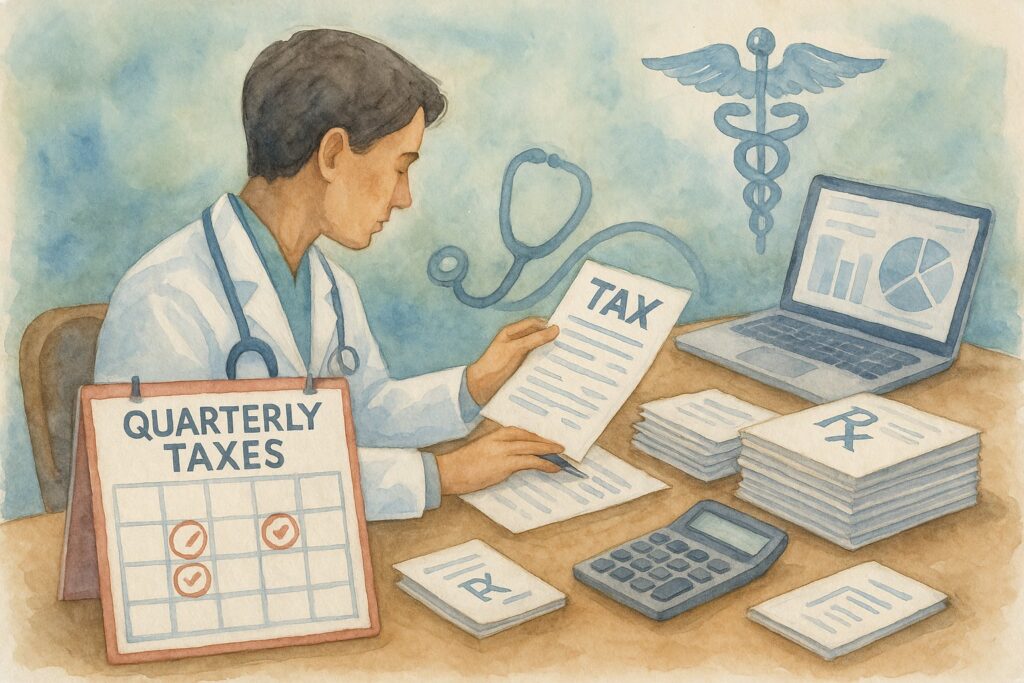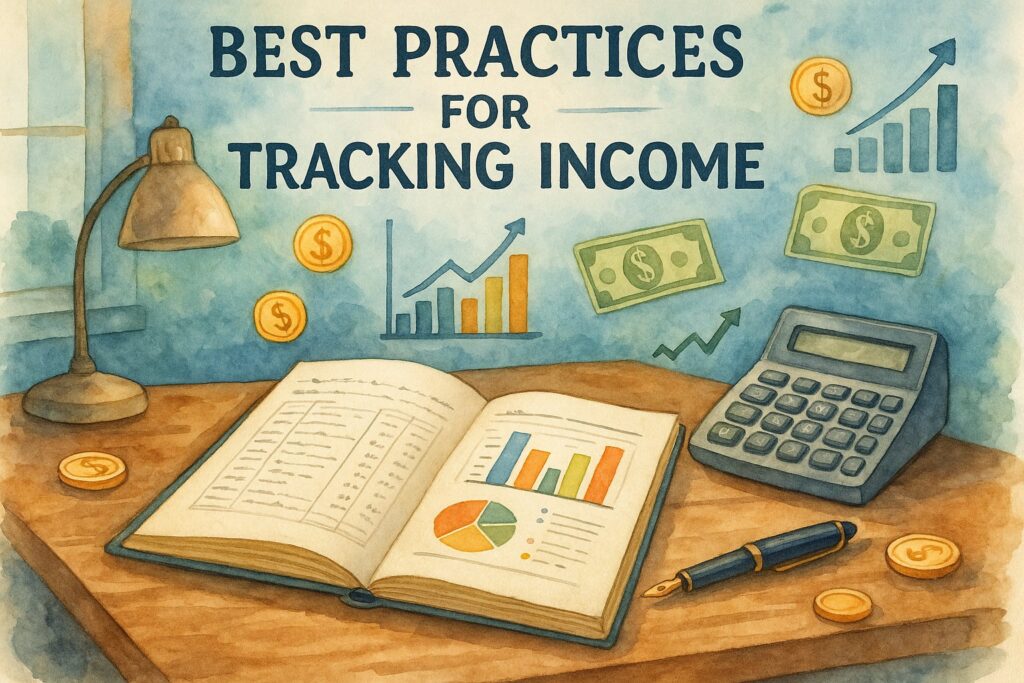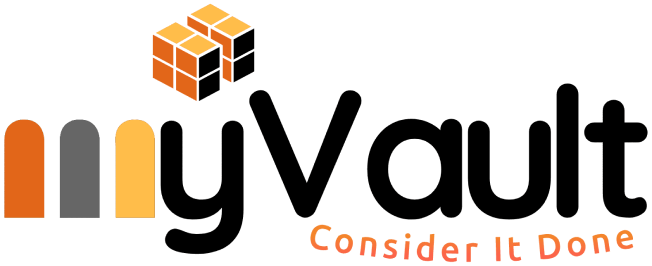
Managing quarterly taxes can feel overwhelming when your work takes you across states or you balance multiple contracts. Whether you’re a travel nurse, locum tenens provider, or an independent practitioner, staying compliant requires careful planning. You can stay ahead of the IRS and avoid costly penalties by understanding your quarterly tax obligations and setting up a system that works for your schedule.
You deal with unique challenges, like shifting tax homes, variable income, and self-employment responsibilities. Tracking earnings accurately and knowing what qualifies as a deductible expense can make a significant difference in how much you keep. Simple strategies such as setting aside funds regularly and using digital tools for income tracking help reduce stress during payment deadlines.
When you approach quarterly taxes with a clear plan, you not only protect your income but also create opportunities to maximize deductions and streamline your financial workflow. By learning practical methods tailored to healthcare travelers and independent practitioners, you can turn a complex process into a manageable routine.
Key Takeaways
- Know your quarterly tax responsibilities to avoid penalties
- Track income and expenses consistently for accurate reporting
- Use simple systems to streamline payments and maximize savings
Understanding Quarterly Tax Obligations

Quarterly estimated taxes cover income that isn’t subject to automatic withholding, such as self-employment earnings, multi-state income, and certain business activities. You need to calculate and pay these taxes on time to avoid penalties and interest.
Who Needs to Pay Estimated Taxes
You must pay estimated taxes if you expect to owe at least $1,000 in federal taxes after subtracting withholding and refundable credits. This applies to independent practitioners, locum tenens providers, and traveling healthcare professionals without an employer handling withholding.
Self-employment income triggers both income tax and self-employment tax (covering Social Security and Medicare). If you work across multiple states, you may also need to make estimated payments to more than one state.
Healthcare travelers often have irregular income, making underpayment more likely. Using prior-year tax liability as a benchmark can help determine whether you meet safe harbor rules and avoid penalties.
Key Deadlines for Healthcare Travelers and Independent Practitioners
Estimated tax payments are due four times a year. The IRS schedule is:
| Payment Period | Due Date (Typical Year) |
|---|---|
| Jan 1 – Mar 31 | April 15 |
| Apr 1 – May 31 | June 15 |
| Jun 1 – Aug 31 | September 15 |
| Sep 1 – Dec 31 | January 15 (following year) |
If a deadline falls on a weekend or federal holiday, the due date moves to the next business day.
As a healthcare traveler, you may need to track deadlines for multiple states. Some states align with federal due dates, while others set different schedules. Missing a state deadline can result in late payment penalties even if your federal payments are on time.
IRS Forms and Documentation Requirements
The primary form for calculating estimated taxes is Form 1040-ES. This includes worksheets to project taxable income, deductions, and credits. You can submit payments electronically through the IRS Direct Pay system, the Electronic Federal Tax Payment System (EFTPS), or by mailing a payment voucher.
Keep records of all income sources such as locum contracts, 1099 forms, and state-specific income statements. Track deductible expenses like travel, licensing fees, and continuing education.
Maintaining organized records ensures accurate quarterly calculations and simplifies year-end filing. Inconsistent documentation often leads to errors, underpayment, or missed deductions that increase your tax liability.
Best Practices for Accurate Income Tracking

Accurate income tracking ensures that you meet tax obligations on time and avoid errors that could lead to penalties. By keeping detailed records and verifying them against reliable sources, you create a clear financial picture that supports compliance and simplifies quarterly filings.
Organizing Multiple Income Sources
As a healthcare traveler or independent practitioner, you may receive income from staffing agencies, direct contracts, or locum tenens work. Each source often provides different documentation, such as 1099s or pay stubs, which can complicate tracking.
Create a system that separates income streams by payer. For example, use folders labeled by employer or contract, both digitally and physically. This prevents confusion when reviewing totals at quarter-end.
A simple spreadsheet can also help. Include columns for payer name, payment date, gross amount, and tax withholdings (if any). Updating this regularly makes it easier to reconcile with official tax forms later.
Maintaining Digital and Paper Records
Digital tools make income tracking more efficient, but paper records remain important for backup. You should maintain both formats to reduce the risk of missing documentation.
Scan or photograph paper checks, contracts, and invoices, then store them in secure cloud storage. Use consistent file naming, such as AgencyName_PaymentDate_Amount.pdf, to make retrieval quick and straightforward.
Keep physical copies of critical documents like contracts and year-end tax forms in a labeled binder or filing cabinet. This dual system ensures that if one method fails, you still have reliable access to income records.
Reconciling Bank Statements with Work Assignments
Bank statements provide a reliable way to verify that payments match your records. By reconciling deposits with your work assignments, you can confirm that all income has been captured accurately.
Set aside time each month to compare your bank deposits with your income log. Mark any discrepancies, such as delayed payments or unexpected amounts, and follow up with the payer immediately.
Consider using a table to streamline reconciliation:
| Assignment | Payer | Expected Payment | Bank Deposit | Verified (Y/N) |
|---|
This process not only ensures accurate reporting but also helps you detect missing or late payments before quarterly deadlines.
Strategies to Simplify Quarterly Tax Payments

Managing quarterly tax payments requires consistent systems, accurate calculations, and the right tools. By focusing on automation, careful estimation, and professional resources, you can reduce errors and avoid unnecessary penalties.
Setting Up Automated Payments
Automating your payments helps you stay on schedule and avoid late fees. The IRS allows you to schedule electronic funds transfers through the Electronic Federal Tax Payment System (EFTPS). Many state tax agencies also provide similar online portals.
You can link a business checking account and set recurring payments for each quarter. This removes the need to remember deadlines manually. If your income varies, you can adjust the payment amount before the due date while still keeping the schedule intact.
Some practitioners prefer using accounting software that integrates directly with EFTPS. This allows you to track payments in real time while maintaining clear records for year-end reporting. Keeping confirmations of each transaction ensures you have documentation if questions arise later.
Calculating Estimated Tax Amounts
Accurate estimates are essential to avoid underpayment penalties. The IRS expects you to pay either 90% of your current year’s tax liability or 100% of the prior year’s liability (110% for higher incomes). Meeting one of these thresholds generally keeps you in compliance.
Start by tracking your gross income and deductible expenses monthly. Healthcare travelers often have variable income, so updating projections regularly prevents large shortfalls. Many practitioners set aside 25–30% of each payment received in a dedicated tax savings account to cover federal and state obligations.
You can also use IRS Form 1040-ES worksheets to calculate quarterly payments. These worksheets help you estimate income, deductions, and credits, then divide the total into four installments. Keeping detailed records ensures your numbers align with actual earnings when you file your annual return.
Utilizing Tax Software and Professional Assistance
Tax software can simplify calculations, reminders, and electronic filing. Programs such as QuickBooks Self-Employed or TurboTax Self-Employed allow you to track income, categorize expenses, and generate quarterly payment estimates automatically. Many also integrate with bank accounts for real-time updates.
If your practice involves multi-state work or complex deductions, consulting a tax professional can be worthwhile. A CPA or enrolled agent can ensure compliance with federal and state rules while identifying deductions specific to healthcare practitioners, such as travel-related costs.
Professional guidance also helps you adjust payments when your income changes significantly. By combining software for routine tracking with expert advice for complex situations, you can maintain accuracy without spending unnecessary time on manual calculations.
Avoiding Common Mistakes and Maximizing Deductions

You reduce tax stress when you know which expenses qualify, understand how state rules apply, and keep track of regulatory changes. Careful attention to these areas helps you avoid penalties while capturing every deduction you are entitled to claim.
Identifying Deductible Expenses for Healthcare Professionals
As an independent healthcare worker, many of your business-related costs are deductible. Travel expenses, such as mileage between assignments, lodging, and meals while away from your tax home, often qualify. Keeping receipts and using a mileage log app strengthens your records if the IRS requests proof.
You can also deduct professional expenses like licensing fees, continuing education, malpractice insurance, and uniforms. If you maintain a home office that is regularly and exclusively used for work, a portion of rent, utilities, and internet costs may apply.
Organizing expenses into categories makes quarterly tax payments easier. For instance:
| Expense Category | Examples |
|---|---|
| Travel & Lodging | Mileage, hotels, rental cars, airfare |
| Professional Costs | Licenses, certifications, insurance |
| Office/Home Office | Rent, utilities, internet, supplies |
| Education & Training | Courses, workshops, conferences |
Consistently tracking these items ensures you don’t miss deductions that reduce taxable income.
Addressing State-Specific Tax Considerations
If you travel across multiple states for work, you may need to file in more than one jurisdiction. Some states require nonresidents to pay income tax on earnings within their borders, even if you live elsewhere. This creates a multi-state filing obligation for many healthcare travelers.
You should also check whether your home state offers a credit for taxes paid to another state. Without this, you risk double taxation. States differ in how they handle per diem reimbursements and travel stipends, so review the rules before filing.
Maintaining a permanent tax home is critical. If you cannot establish one, the IRS may consider you an itinerant worker, disallowing travel deductions. Documenting ties to your primary residence—such as mortgage payments, voter registration, or utility bills—helps preserve eligibility for travel-related deductions.
Staying Updated on Tax Law Changes
Tax laws affecting independent practitioners shift frequently, particularly around deductions, credits, and reporting requirements. For example, recent years have seen adjustments to standard mileage rates and changes in rules for meal deductions. Missing these updates can lead to under- or overpayment.
You should regularly review IRS announcements, state tax department updates, and professional tax resources. Subscribing to updates from a CPA who specializes in healthcare professionals can save time and reduce errors.
Even small changes, such as modifications to retirement contribution limits or allowable business expense categories, can affect your quarterly estimates. By staying informed, you avoid surprises at year-end and ensure your payments reflect current law.
Frequently Asked Questions
You need to stay organized with documentation, understand how to calculate estimated payments, and keep track of strict quarterly deadlines. State residency, eligible deductions, and potential penalties also play a major role in how you manage your tax responsibilities.
What are the essential documents needed for filing quarterly taxes as a healthcare traveler?
You should keep copies of all pay stubs, 1099 or W-2 forms, and any contracts from staffing agencies. Maintain receipts for travel, lodging, meals, and professional expenses. A record of your permanent tax home address is also important for proving eligibility for certain deductions.
How can independent practitioners accurately estimate their quarterly tax payments?
You can use IRS Form 1040-ES to calculate estimated payments based on your expected income, self-employment tax, and deductions. Reviewing last year’s tax return can give you a reliable baseline. Many practitioners also use accounting software or consult a tax professional to avoid underpayment.
What are the deadlines for submitting quarterly taxes for healthcare professionals?
Quarterly estimated tax payments are generally due on April 15, June 15, September 15, and January 15 of the following year. If the due date falls on a weekend or holiday, the deadline moves to the next business day. Missing these dates can result in penalties.
Are there any specific deductions that healthcare travelers should be aware of when filing taxes?
You may qualify to deduct temporary housing, mileage, licensing fees, and continuing education costs if you maintain a qualifying tax home. Meals during assignments and certain travel-related expenses can also be deductible. Keep detailed records to substantiate each deduction.
What penalties could be incurred for failing to comply with quarterly tax requirements?
If you underpay or miss a deadline, the IRS may charge interest and penalties on the unpaid amount. Penalties are calculated based on how late the payment is and how much you owe. Consistent underpayment can lead to higher financial consequences over time.
How does state residency affect quarterly tax filing for healthcare travelers?
Your state of residency determines where you file your primary tax return, but you may also need to file in states where you worked. Some states offer tax reciprocity agreements, while others require nonresident returns. Tracking each assignment location helps you avoid filing errors and double taxation.
Need Tax Help? SUBMIT INQUIRY

https://shorturl.fm/CLuYI
Get instant deposits with 1win apk download.
💡 Excellent work on this ultimate guide! every paragraph is packed with value. It’s obvious a lot of research and love went into this piece. If your readers want to put these 7 steps into action immediately, we’d be honoured to help: 👉 https://meinestadtkleinanzeigen.de/ – Germany’s fastest-growing kleinanzeigen & directory hub. • 100 % free listings • Auto-sync to 50+ local citation partners • Instant push to Google Maps data layer Drop your company profile today and watch the local calls start rolling in. Keep inspiring, and thanks again for raising the bar for German SEO content!
https://shorturl.fm/9yC3t
Lucky Jet is loved for its fairness and exciting gameplay.
Aviator is a chance to win relying on reaction and intuition.
https://shorturl.fm/baWnq
https://shorturl.fm/CFxlc
https://shorturl.fm/t8Dvs
https://shorturl.fm/VIuQ4
https://shorturl.fm/GFXIo
https://shorturl.fm/ukE0O
https://shorturl.fm/RiRjB
https://shorturl.fm/fdEGM